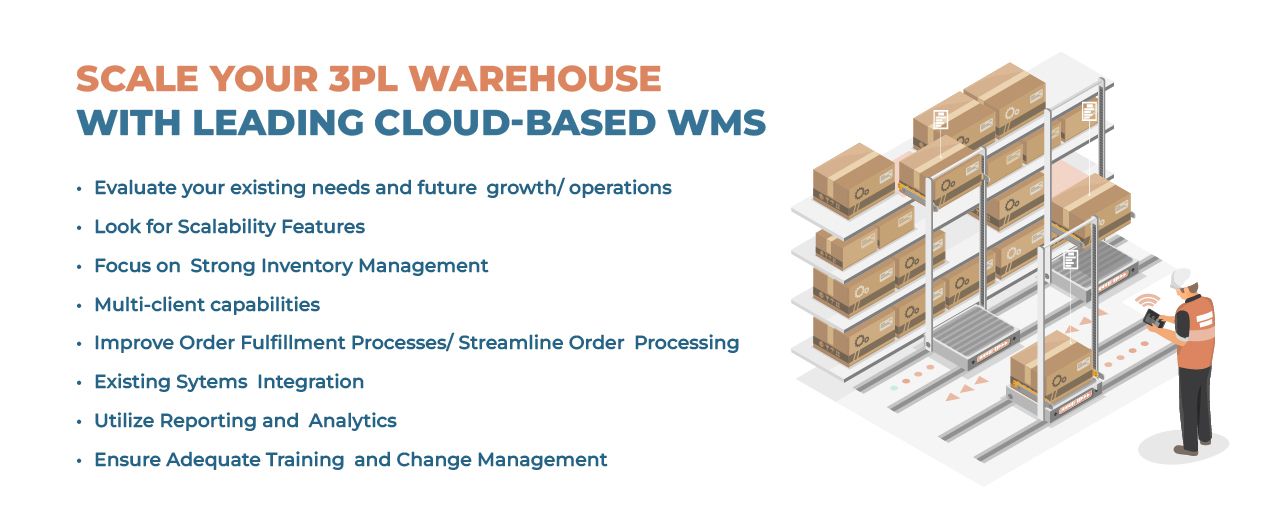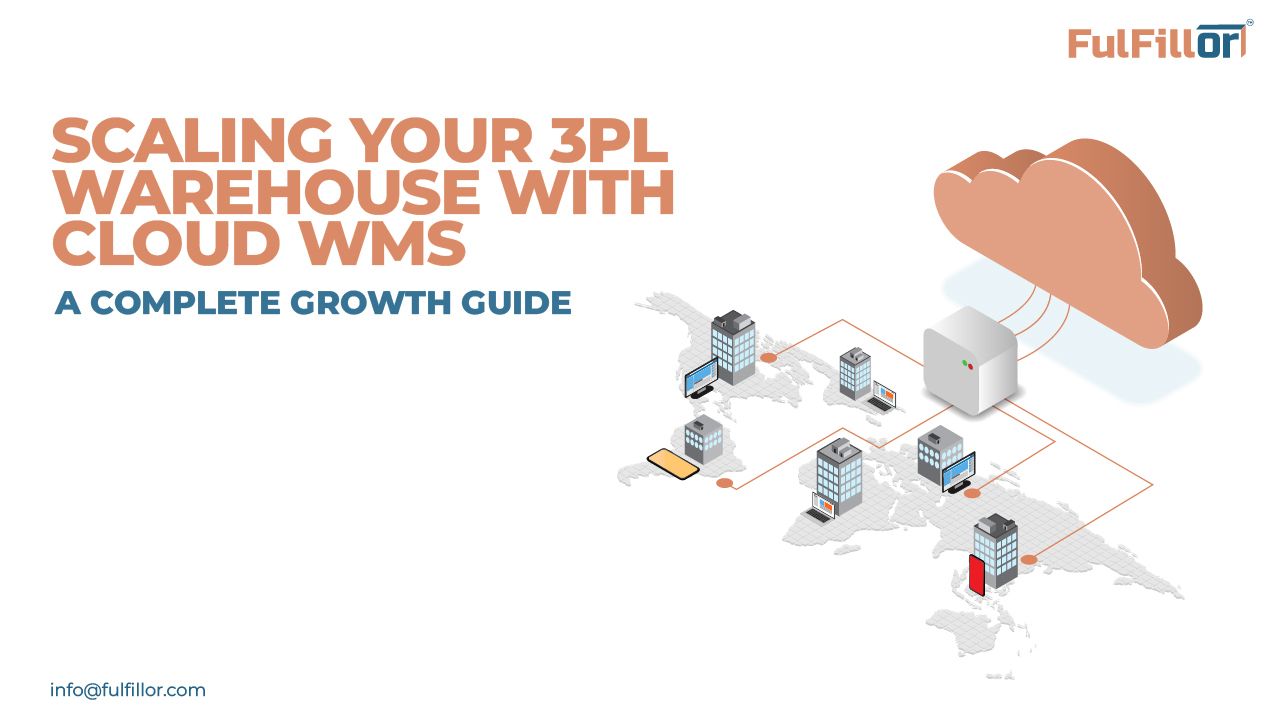Scaling Your 3PL Warehouse with Cloud WMS: A Complete Growth Guide
Imagine this: your business is booming, orders are on the rise, and customers demand rapid shipment and flawless precision. Sounds exciting, right? But here’s the wake-up call — your 3PL warehouse management is struggling to catch up. Orders are being delayed, errors are slipping in, and your legacy processes are falling behind. Frustrating? Absolutely.
Don’t panic, you’re not the only one. A recent study reported that 70% of 3PL warehouses still depend on manual or outdated systems to manage their operations. If you’re still using spreadsheets to manage inventory or struggling with disconnected software, scaling your 3PL warehouse management might seem impossible. But what if you could easily scale your 3PL warehouse management? This is where Cloud-Based WMS (Warehouse Management Software) comes into play.
Let’s dive into how cloud-based WMS can help you scale your 3PL warehouse smoothly and efficiently.
Understanding 3PL Warehouse Management
Third-party logistics (3PL) warehouse management is the process of outsourced management of warehousing, inventory, and order fulfillment for multiple clients. In contrast to traditional warehousing, 3PLs function in a fast-paced, high-volume context where strategies should be efficient, flexible, and scalability. To be successful, 3PL warehouses need to tackle: inventory from various clients, varying fulfillment requirements (B2B, B2C, retail, eCommerce), & ever-changing order fulfillment and shipping needs. The challenge? Handling all of this while scaling without breaking operations. That’s where a cloud-based WMS swoops in.
What is Cloud-Based Software for Warehouse Management?
Imagine cloud-based WMS (Warehouse Management System) as the command center for your warehouse — available anytime, anywhere. Unlike traditional systems that you need to install as costly hardware, a cloud-based WMS runs on remote servers, giving you the scalability, flexibility and real-time data you need without the IT infra headaches. Cloud-based WMS software enables task automation, instant data access, and stakeholder collaboration. Now, let’s dig into how this technology scales your 3PL warehouse.
Scale Your 3PL Warehouse with Leading Cloud-Based WMS
Growing your warehouse doesn’t mean building more shelves or hiring more people. It’s about making processes efficient so your business can scale without collapsing. Select a cloud-based WMS with features that scale with you to manage growing inventory levels and client needs, as well as the ability to integrate with your ERP and other systems easily allowing you to efficiently oversee operations as your business grows while utilizing the scalability advantages of a cloud platform.
Important features include selecting a system with powerful reporting features, solid inventory management tools, and the ability to handle when business has multiple warehouse locations or client orders at once.
Here are some of the key aspects that you should consider while choosing a cloud based warehouse management system for you 3PL Warehouse:

1. Evaluate your existing needs and future growth/ operations:
Before making a move, it’s important to pause and assess the current status of your 3PL warehouse. Understand your current warehouse constraints and expected growth to select a Cloud WMS capable of coping with more order volume, more product types, and potentially different customers. Ask yourself:
- How many orders do you process per day?
- What are the fulfilment challenges we have?
- Are we having difficulty with inventory accuracy?
- Are we ready for surges during peak season?
Identify bottlenecks by talking to your warehouse staff and clients. The proper WMS should resolve your issues now and set you up for future expansion/growth.
2. Look for Scalability Features
Not every system scales along with your business needs. Search for a solution that provides flexible storage configurations, can easily scale with new warehouse locations, and also integrate with other services as your business grows, such as shipping carriers.
3. Focus on Strong Inventory Management
Poor inventory management = Lost sales. A strong warehouse management system supports advanced inventory tracking developed in its application such as real-time visibility of stock levels, lot and serial number tracking, and automated inventory adjustments to ensure multi-client accuracy and to avoid mix-ups.
4. Multi-client capabilities
Serving multiple clients? Thus, your warehouse management system should be capable of managing orders and dedicated inventory management for multiple clients at a time, and automated stock tracking to avoid mix-ups between clients. Make sure the WMS has separate/custom reporting and billing features to prevent collisions and keep everything clear.
5. Improve Order Fulfillment Processes/ Streamline Order Processing
Quicker fulfilment = more satisfied clients and customers. Features such as wave picking, pick-and-pack optimization, and automated shipping label generation will help to streamline order fulfillment and minimize processing time.
6. Existing Systems Integration
Your WMS should integrate with your existing tools — not tear them down. Select a solution that offers seamless integration with your current ERP software (SAP, NetSuite, Microsoft Dynamics), accounting systems (QuickBooks, Xero), e-commerce platforms (Shopify, Amazon, WooCommerce), and shipping carriers (FedEx, UPS, DHL, USPS)
7. Utilize Reporting and Analytics
Trying to scale without data-driven insights is like trying to drive blindfolded. Look for a warehouse management system with extensive reporting capabilities that allow you to track Key Performance Indicators (KPIs) and make data-driven decisions. Find a WMS that offers real-time dashboards, and warehouse performance reports that can be customized to your specs. You can then use these data-driven insights to streamline operations, decrease waste, and enhance efficiency.
8. Ensure Adequate Training and Change Management
Moving to a cloud-based WMS is a huge shift but your team needs to be on board. However, you must thoroughly train your warehouse employees on reporting and using the new cloud-based WMS software, such as troubleshoot the software and optimize process methods. As a Third-party Logistics (3PL) provider, implement hands-on training for warehouse staff, offer clients self-service guides for their operations, and move the operations gradually.
Cloud-based WMS – why switch?
Here are the reasons why you need to switch to a cloud-based WMS. They save resources because you do not have to maintain on-premise hardware and software.
- Cost: The elimination of the need to maintain on-premise hardware and software means you scale as your demand increases and scale down as necessary.
- Access Anytime and Anywhere: Access to data and operations from any device with internet connectivity enabling remote monitoring and management.
- Agility: Adjust quickly to changing business demands and accommodate specific upper client needs without a full system overhaul.
- Enhanced operational efficiency: Automating warehouse processes helps in faster order fulfillment and decreased errors.
Top Cloud-Based WMS Solutions for 3PLs

There are multiple leading WMS solutions designed for 3PLs, such as:
- Fulfillor: A high-performance open-source WMS especially for 3PL scaling
- Manhattan Associates: AI-driven optimization enterprise-grade WMS
- Infor CloudSuite WMS/Cloud: Cloud Supply Chain Automation.
- JDA Warehouse Management: Enhanced logistics and fulfillment capabilities.
- Extensiv: A highly extensible 3PL fulfillment platform.
- NetSuite WMS: Cloud ERP system with built-in WMS functionality.
Closing Thoughts: Should You Upgrade Your 3PL Warehouse?
3PL warehouse scaling may seem like a giant task, but with the right cloud-based WMS, you can achieve amazing results! So whether you’re a startup with hundreds of orders, or established enterprise, handling thousands, a cloud-based WMS adapts, grows and scales with you.
So, what are you waiting for? Get in touch with us at info@fulfillor.com today and find out how our solutions can help you simplify operations, increase speed and accuracy in fulfilment, and scale your business.
The future of 3PL warehousing is in the cloud.
Ready to streamline your 3PL warehouse Operations ?
Schedule a call with our experts to know more about Fulfillor - Cloud based warehouse management system for 3PLs.

